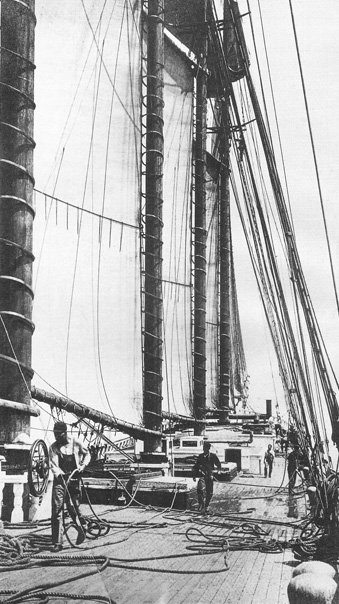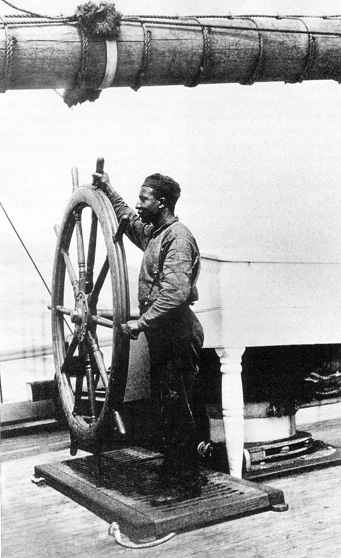Hard Knocks
by Mike Crowe

Of the seven men at work hoisting sail on this schooner the three most visible are African American. Deck hands were not well paid, but among their shipmates African American sailors earned higher rank and earnings than their peers ashore. Photo courtesy Maine Maritime Museum.
In recent years, historical records have shown that around the time of the American Revolution, as much as 25 percent of American mariners were African-American. This was not the beginning of their working at sea, for there is evidence they sailed as translators on slave ships in the 1600s, were among pirate crews, and for many years sailed aboard whaling ships. But it was on merchant ships that their status rose from cooks, stewards and cabin boys, until, by the revolution, they were engaged as able-bodied seamen.
Before the revolution, most every person of color in the British North American colonies was a slave, after it, there were an estimated 60,000 freed men. The American Revolution was the first major opportunity for freedom. Privateers and state navies, including Massachusetts and Connecti-cut, actively enlisted blacks. It was the beginning of freed slaves gaining a degree of social position in the industry. The American shipping industry boomed in the first half of the 1800s, and African-Americans went to sea in large numbers, mostly from northern states.
The scene aboard ship, however, was not one of black and white mates cheerily singing sea shan-ties over a mug up in the fo’castle. While most African-Americans were still slaves on land, aboard ship, where reliable ability was more the measure of a man, freedom and status could be, and was, gained. Some became captains of vessels, long before the Civil War. Their status at sea was gener-ally better than on land, but equality would, at best, be an exaggeration. Yet there were far more African-American sailors — who held higher rank and earned more money than some of their white peers aboard ship — than there were ashore.
If ever there were a school
of hard knocks, it was
aboard merchant ships
in the days of sail.
In colonial America, going to sea was an opportunity for many young men. They went at ages that current labor laws would not allow. For some, it was a desperate attempt at survival, but many were the sons of affluent families, for whom it was an apprenticeship in an industry with po-tentially great financial rewards.
Going to sea at 12 or 14 years of age meant some would captain a ship in their twenties. In the agrarian, pre-industrial 1700s, shipping was “the” big business, and the captains of industry were the captains and owners of ships.
In the British and the early American navies, young midshipmen from affluent and influential families were the most probable, very nearly the only sailors, to get their own ships. But in the merchant marine, advancement could be more democratic. However, if ever there were a school of hard knocks, it was aboard merchant ships in the days of sail.
Massachusetts was the first to make slavery legal in 1641, and one of the first, after Maine, to declare opposition to it. The Quakers, with relaxed strictures around religion and race, welcomed African-Americans. It was in whaling that relatively large numbers of them first went as sailors and craftsmen. Whaling was one of their earliest seafaring occupations.
Their involvement in whaling, and the early dependence of whale ship owners on Native Ameri-cans and African-Americans in hunting whales, led to opportunities, of sorts. A few African-Americans eventually owned whaleships on Nantucket and in New Bedford. The wealth from these ships made for them a place in their largely white communities, but they were the exceptions, by a wide margin.
Whaling was the oil industry before petroleum. and the profits were comparable to current oil company profits, though probably higher. Yet the pay for crew members was practically slavery. American industrial whaling started at Sag Harbor, Long Island, N.Y., in the 1600s. But when the Quakers fled the Pilgrim mainland, seeking their own version of religious freedom on Nantucket in the late 1600s, they got into the business and rapidly took over the market.
The Quaker success was the result of a few things: their isolation on what was basically a sand bar where they could barely produce food; the availability of inshore whales; local Indians who knew how to kill them, and the Quaker’s willingness to hire anyone who would work for subsistence wages.
It was aboard the Quaker whaling ships that Native American and African-Americans played important roles. Local tribes taught the Quakers how to harpoon whales and the African-Americans were hired because they were up to the task.

The crews of many of the great schooners were composed of white officers and engineers, with the bulk of the deckhands being made up of African Americans. At times more than 20 percent of American seamen have been African American. The photo was taken aboard the Bath built 305’ schooner Davis Palmer. Photo courtesy Maine Maritime Museum, Palmer Collection.
Stories are told of an Indian whale-hunting technique, where the hunter leapt onto the back of a passing whale and drove a wooden plug into it’s blow hole, suffocating the animal. The site must have caused a few green hands to shrink from the rail and consider career options. However, the basic tool, which had been devised by Native Americans, and which became the standard of the in-dustry, was the harpoon with a detachable barb. But this fact, and the African-American’s willing-ness to work, did not affect the size of their share of the catch. Theirs was usually among the small-est, sometimes 1/250th. Required to buy their gear at the company store, it was not unheard off for a whaleman to come back from three years at sea owing the company money.
Whaleship owners were notoriously exploitive of crews, but slaves or freedmen had few other choices. A few managed to come out ahead. Many more did better working in the yards that built and maintained the whaleships.
The shipping industry and maritime culture was less restrictive, in some ways, than those on shore. Finding land to own, or a job to hold, remained difficult for freed slaves after the Revolution and the Civil War. Going to sea was a job, but for some it was also a means of escaping slavery. Running away from slavery was common, but literally running overland was dangerous. Aboard ship, escape might be complete as soon as the anchor was hauled. It has been said that if there was an underground railroad, it was in the form of a sailing ship, because so many slaves escaped aboard ships. Runaways often found African-Americans among the crew who were willing to help them. The ship might be a long-term home or just transportation north.
The former slave, famed public speaker, and leading abolishionist, Frederick Douglas, worked as a ship caulker in New Bedford. Douglas had escaped slavery in Maryland wearing a freed friend’s sailor’s clothes and used the friend’s protection papers to get to New Bedford. Douglas came north by train, but worked caulking whalers when a Quaker Society of Friends member got him the job.
The admiralty laws and maritime culture that made it easier for African-Americans to work and succeed at sea, also made life at sea more like slavery for free men. Rules were sharply defined, strictly enforced, and infractions harshly punished. Whipping was a standard punishment. A cap-tain could trade crew members with other captains. Movement ashore was often restricted by port regulations. Sailors were considered a breed apart, and so treated by some governments. “Liberty” meant just that — freedom from the ship.
If there was an
underground railroad,
it took the form
of a sailing ship.
Census records from Portland, Maine, indicate there were several African-Americans living there around 1850, whose occupation was seaman, with their particular position—cook, carpenter, sail maker — stated.
Maine didn’t have a large African-American population, but their numbers in Portland were dis-proportionate to both the rest of the state and other coastal towns. The 1850 census listed 67 in maritime-related occupations. Portland was a major port, where many sailors arrived, and some stayed. The state was known to be opposed to slavery from very early days, and this may have made staying more probable for some, at least before the Civil War. During the Civil War, 75 Afri-can-Americans, from Wells to Eastport, are documented as having served in the Union Navy.
There was a small presence of blacks in towns along the coast who lived, worked, and in some cases, operated businesses. In the late 1700s, Thomas Frazer settled in what is today Winter Harbor, Maine. There he made salt and sold it to passing ships from a place on shore named after him, Frazer Point.
Maine was not home to most African-American sailors, but most African-American sailors prob-ably sailed on Maine-built ships. By the middle of the 1800s, Maine was the largest producer of ships in America. Nathaniel Palmer of Bath built and operated several schooners in the late 1800s. The opinionated Palmer injected himself into decisions about every aspect of the operation of his large business. They ranged from details of the construction of a wheel house to the racial composi-tion of a crew. Palmer may have considered African-Americans equally skilled and capable, but he insisted on either all black crews, all white crews, or separate quarters for mixed-race crews. This was not the norm historically, but it was a sign of the times. In some ways, things had deteriorated at sea in the 100 years since the Revolution.
As the country, the economy and shipping changed, so did the role of African-American sea-farers. After the Civil War, there were many more African-Americans who could go to sea. At the same time, the large schooner — with it’s smaller crew — was becoming the ship of choice. The trans-continental railroad was built, creating the first credible competition for shippers. Toward the end of the 1800s, large numbers of Europeans arrived, increasing competition for jobs on ships and in shipyards. Diminishing the rights gained in the Civil War was increased racial discrimination. Soon after the turn of the century, the age of sail ended. The result of it all was a declining presence of African-Americans at sea, in shipyards, and apparently in some of the museums since built on the vacant wharfs.
